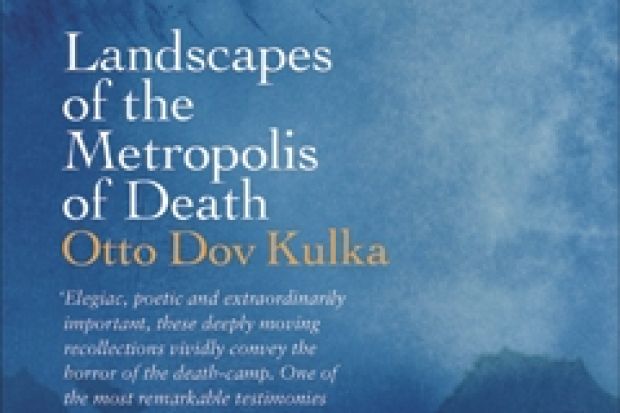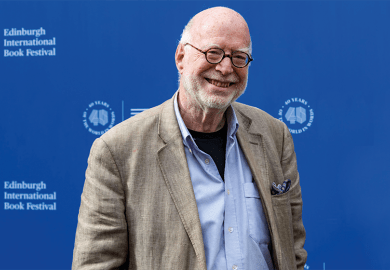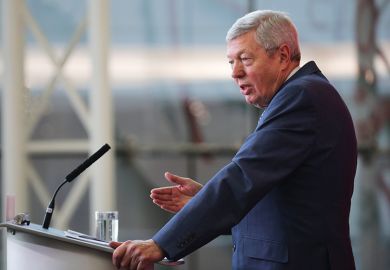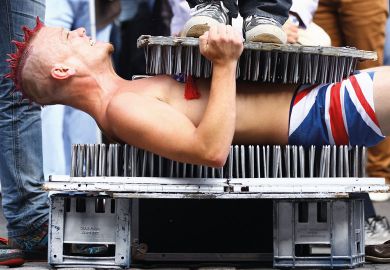The author of this astonishing book sang the Ode to Joy in a children’s choir at Birkenau, “like little angels, our voices providing an accompaniment to the processions … into the crematoria”. All his life since then, he has asked himself what drove the conductor to choose that famous declaration of human dignity. Was it a protest, “as long as man breathes he breathes freedom, something like that?” or was it “an act of extreme sarcasm … of self amusement, of a person in control of naive beings and implanting in them naive values, sublime and wonderful values, all the while knowing that there is no point or purpose and no meaning to those values”? Otto Dov Kulka, a very eminent historian of the Holocaust, can find no answer. He chooses first one then the other, and each choice “is in fact the whole unfolding of my existence or of my confrontation both with the past and with the present from then until today”.
This sort of agonising existential question, the impossibility of an answer to it, yet the crucial importance of such an answer and the burden of memory, are the focus of Kulka’s reflections. There are enough Holocaust survivor memoirs by historians to make a little canon. One of these, When Memory Comes, by the great Holocaust historian Saul Friedlander, is a classic of this small but fascinating and important genre. Landscapes of the Metropolis of Death deserves a place with that volume. It is, quite simply, extraordinary.
As a historian, Kulka avoided any “integration” of his own life story with his research: so much so that, for example, in 1978, a well-meaning colleague, on hearing he planned to visit Auschwitz, suggested breezily, like a tour guide, that he ignore the main camp and “go to Birkenau - that is the real Auschwitz”. Kulka’s hope had been that his highly regarded historical research would be “infused” with a consciousness of the intensity of those events he witnessed. However, he suggests, the “safe and well-paved way of scientific discipline” led him to skirt precisely the violence, the murder and torture he had seen (“as perhaps I skirted the piles of skeletons in Auschwitz on my way to the youth hut”). This “safe passage” of the discipline of history led him, he thinks, both not to be able to convey “the message” that was “burned into” his being and at the same time to cope with precisely that inability to tell it.
But this book is not a work of history, nor even of straightforward memoir. It is like - paradoxically, and I can’t find a better way to describe it - a history with the history taken out. It is like seeing not the map but only the cartographer’s points of orientation. It is not “against” history but “beyond” or “below” history, striving to illuminate what Kulka calls the “tremendous ‘meta-dimensional’ baggage and tensions”, philosophical and personal, that underlie his historical work.
To do this, against the grain of his training and his own habits of mind (“what I am doing here actually runs contrary to all my decisions, all my feelings, the whole awareness of my limitations”), Kulka lays out an incredibly personal exposition of his own “interior landscape”, his own mythology of the “Metropolis of Death”, of Auschwitz. He names the “Great Death” (the gas chambers) but also what he names the “Small Death” (the electrified fence) and the “Life beyond Death”, recalling the occasion where he was almost electrocuted on the fence, hanging a moment “after death” (“I am dead, and the world as I see it has not changed! Is this what the world looks like after death?”) until he was saved by being pushed off the wire by a wooden pole. He describes the last time he saw his mother before the “Great Death overtook” her. There is a narrative, a map, but it is told not as a chronicle but as a series of moments, flashes, impressions, ideas, illuminations, epiphanies, poems, even dreams and recalled daydreams. The style is terse, often simply descriptive. No helping hands or easy answers are provided. It is a sort of Modernist precipitate of a historical work, something strange and powerful formed from, but separate to, the solution of history.
Landscapes of the Metropolis of Death exists in a triple perspective, each interweaving and interlocking. With a child’s eye, Kulka describes, for example, how he admired the beauty of the blue skies of summer over Auschwitz while imprisoned there, and how he was almost immune to the frightful disorientation of camps - a disorientation which itself killed adults - since he knew no other order. As a historian, he both poses the question of why the inmates of the “family camp” in Auschwitz in which he was held were treated so differently, and answers it (the sub-camp was planned as a “show camp” for the Red Cross, and was suddenly “liquidated” when the Nazis found it was no longer necessary). As a survivor, he discusses his intense memories and associations. He has, for example, a sudden and absolute feeling on his first visit to the Temple Mount in Jerusalem that he had been there before, because the desolation there and at a “ruined” Auschwitz in 1946 (he was there to give evidence at a trial) were both so “charged with historic meaning”.
If all this sounds demanding and hard to follow, it is, despite the down- to-earth historian’s prose and clarity of Ralph Mandel’s translation. Indeed, the book is taken up with a fear that real communication about these matters is impossible. Although Landscapes of the Metropolis of Death is full of paintings and photographs, reminiscent of the work of W.G. Sebald, Kulka himself avoids artistic and memorial representations of the Holocaust because “I cannot find in them what they seek to convey”. But for this he does not blame the artists or works but rather turns, in seeking to understand this, to Kafka’s famous fable, Before the Law. In this, a man from the country seeks to pass through the gate of the law, but is not allowed to pass through and finally, dying, discovers that the gate exists only for him and will now be closed. Kulka suggests that his mythology exists, perhaps, only for himself, and no other “gate” will open for him. However, he recalls that, in Kafka’s story, the man sees a light glowing faintly from behind the gate of the law.
I can’t tell if this book offers the truth of the Holocaust in this special, existential sense: I’m not sure who could make that judgement. But I can’t see how this book could be bettered as an account of the gate between it and us.
THE AUTHOR
Rosenbloom professor emeritus of Jewish history at the Hebrew University of Jerusalem, lover of classical music and jazz and enthusiastic dishwasher (“an always welcome distraction”), Otto Dov Kulka has lived in Jerusalem with his wife Chaia Kulka, a retired social worker and special- needs teacher, since 1958. Their daughter, Eliora Kulka-Soroka, is a clinical psychologist.
“I live in a modern neighbourhood in the western part of the city, Beit Hakerem, but I am almost magically attracted to the Old City in the eastern part of Jerusalem, to the inside of its ancient city walls and surrounding hills such as the Mount of Olives. It has a unique mixture of religions and ethnicities, of churches, mosques and synagogues, remnants of thousands of years of history in stone, of its glory and destruction through the ages. I often feel the need to get lost in the labyrinth of its narrow streets.”
Were he to live anywhere else “it would unquestionably be Prague, the city I grew up in, with its thousand years of uninterrupted continuity of architectural styles and the wonderfully preserved remnants of its famed Jewish past”.
His father, Erich, was also a historian. Kulka was inspired by “his humanistic approach and preservation of human values even in the most extreme situations of life”, but “our approaches to history were quite different. He combined his personal experience in Nazi concentration camps with his writing of history, both as a witness and as a scholar. In my research these two dimensions, the personal and the scholarly, were always separate. This book is the first time that my personal experience of Auschwitz is dealt with as an antithesis to my historical writing.”
As a young man, Kulka lived on a kibbutz, “where I could combine my passion for agriculture and physical work with the early stages of my academic studies” at the Hebrew University.
The university’s founding ethos, he notes, endures. “Foreign students and guest professors find the atmosphere of a close connection between teachers and students remarkable. Its origins are in the spirit of the young Israeli community, in the creation of a new society and reviving an ancient culture.
“I retired from teaching in 2001 but remain active in instructing PhD candidates, and I’ve completed several research and source publication projects in cooperation with German and Israeli students and institutions. In my present book I’ve dared to deal with questions in history and beyond that I abstained from during my earlier academic career, and I even think I have found answers to some of them.”
Landscapes of the Metropolis of Death
By Otto Dov Kulka
Translated by Ralph Mandel
Allen Lane, 144pp, £14.99 and £9.99
ISBN 9781846146831 and 9780718197018 (e-book)
Published 31 January 2013
Register to continue
Why register?
- Registration is free and only takes a moment
- Once registered, you can read 3 articles a month
- Sign up for our newsletter
Subscribe
Or subscribe for unlimited access to:
- Unlimited access to news, views, insights & reviews
- Digital editions
- Digital access to THE’s university and college rankings analysis
Already registered or a current subscriber? Login




